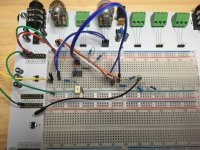Bio77
Well-known member
I wanted to poke around the Low Tide LFO section and see if I can identify changes that would increase the signal. However, in order to breadboard it you need to start with the Atinny chip. The schematic has pins 1, 3, 6, and 7 of the Randomizer not connected to anything. Is this right?
Also, I'm looking for opinions on what values I could change to increase the LFO signal. Right now, I'm thinking lowering R64, look like it would help.
Here is the schematic:
https://docs.pedalpcb.com/project/LowTide-Schematic-PedalPCB.pdf
Also, I'm looking for opinions on what values I could change to increase the LFO signal. Right now, I'm thinking lowering R64, look like it would help.
Here is the schematic:
https://docs.pedalpcb.com/project/LowTide-Schematic-PedalPCB.pdf


